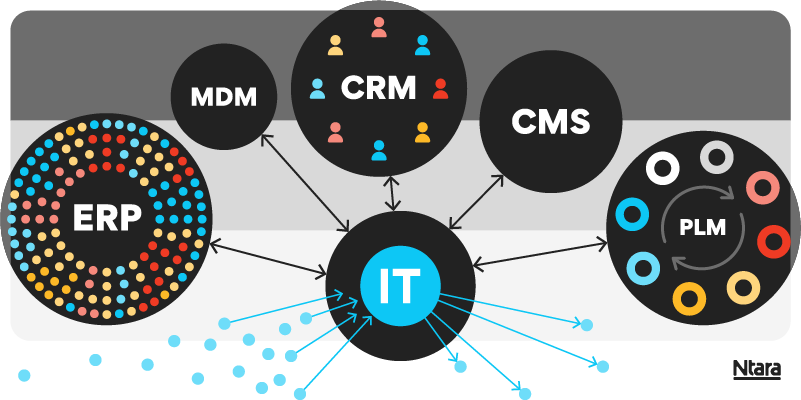In manufacturing, IT teams are responsible for keeping complex systems running smoothly—ERP, PLM, ecommerce, and more. But when product data is scattered across disconnected platforms, IT becomes the default support for every product content request.

New product feed? Updated specs for a distributor? Custom catalog for sales? These one-off requests drain time and resources.
Good news: a better PXM strategy can change that.
PXM puts PIM and DAM software at the heart of your product tech stack, centralizing product content and automating its flow across systems.
That can result in:
- Fewer custom connectors to build and maintain
- Automated workflows that reduce manual intervention
- Scheduled syndication and bulk updates that reduce repetitive tasks
- System monitoring for data flow, API health, and performance
- Governance tools that enforce data standards and access controls
It also results in fewer tickets. Cleaner systems. And more time for IT to focus on infrastructure, security, and innovation.
Product data chaos
Manufacturers sell through a complex web of channels: B2B ecommerce portals, dealer networks, distributors, internal sales teams, and more. Each channel demands accurate, channel-specific product content. But when product data lives in silos, such as ERP, PLM, spreadsheets, and inside people’s heads, who gets called to stitch it all together? IT.
The volume of requests that come in makes IT become the bottleneck. Not because they want to be, but because the systems weren’t built for agility.
PXM is the IT team’s secret weapon
A well-structured PXM strategy, anchored by PIM and DAM software, can automate the chaos. When PIM and DAM are connected to your ERP, PLM, and other back-office systems, business users can easily find the content they need, when they need it.
Here’s how that reduces IT burden:

1. Built-in security
Modern PXM platforms support IT’s top priority—security. These systems are cloud-native, offering high availability, disaster recovery, encryption, SSO, and SOC 2 compliance. They offer enterprise-grade protection out of the box. With PXM systems, IT teams gain peace of mind without the extra overhead.

2. Fewer tickets, happier teams
With a centralized PIM, marketing and product teams have the access they’ve always needed. They can find product data and enrich it without pinging IT. No more emails asking for data from the ERP. Just clean, governed data at their fingertips.

3. Automated syndication
Need to push product content to a distributor portal, ecommerce site, or internal sales tool? PXM automates that. IT sets up the integration once, and the business runs with it—no custom scripts or manual exports required.

4. Governance without gatekeeping
PXM enforces data standards and workflows, so IT doesn’t have to. Instead of manually policing data quality or managing access requests, IT teams can rely on built-in governance tools that provide data validation rules, access controls, audit trails, and workflow automation. The result? IT gains peace of mind knowing that product data is governed, secure, and compliant—without becoming the bottleneck.

5. ERP & PLM stay clean
Instead of over-customizing your ERP or PLM to handle marketing content (which they were never designed for), PXM acts as the layer that translates technical data into customer-ready content—without disrupting your core systems.

6. Scalable architecture
As your product lines, markets, and channels grow, PXM scales with you. IT doesn’t have to reinvent the wheel every time the business wants to launch a new product or enter a new market.
The risk of doing nothing
Without PXM, IT functions as the de facto product content team, fielding requests, building one-off solutions, and firefighting bad data. That’s not sustainable. It slows down time-to-market, frustrates business users, and burns out your team.
Worse, it keeps IT from focusing on strategic initiatives like digital transformation, cybersecurity, and infrastructure modernization.
PXM is a powerful growth strategy for IT. It empowers businesses to manage product content independently, reduce manual work, and build a scalable foundation for growth.
Let’s talk about PXM. Your ticket queue will thank you. Contact us.